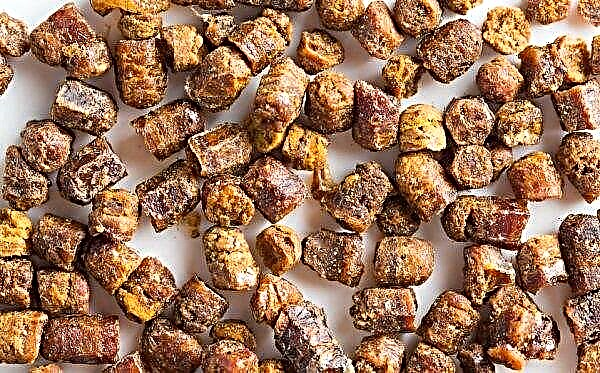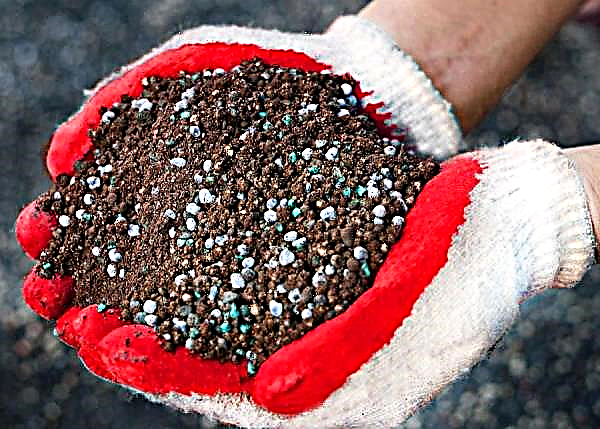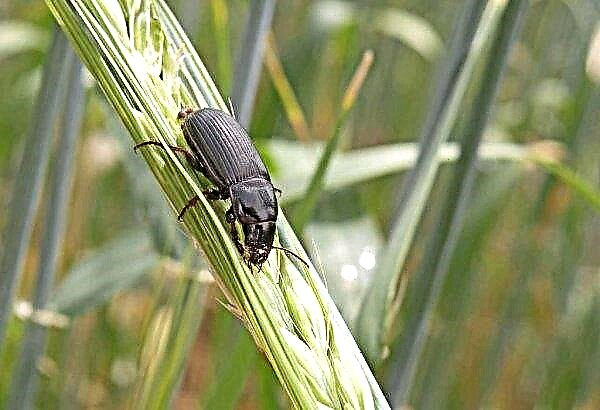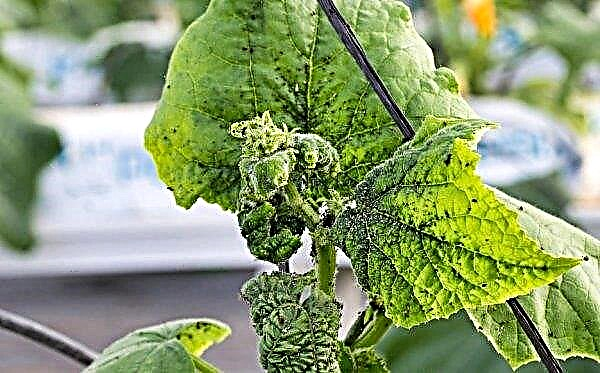Among decorative-deciduous houseplants, croton can be safely called one of the most striking. But the trouble is that even with very careful care, this flower at home very quickly loses its attractiveness, and eventually dies. Find out how to properly care for a capricious plant and what its owner needs to know in this review.
Botanical description of the plant
Croton (Latin name Codiaeum) is a perennial evergreen plant of the family Euphorbiaceae. It is found in nature in the tropical and subtropical forests of Australia, Oceania (Polynesia), India, as well as some islands of Southeast Asia (Malaysia, the Philippines, etc.). Due to the amazing coloring of the leaves, the people sometimes call it “Joseph’s Cloak”.
Despite the fact that the plant came to Europe in the second half of the seventeenth century, the real fashion for it began only three hundred years later. Together with Dieffenbachia and Drazen, croton was initially grown by florists from the Netherlands, and from there it began to conquer the world.Did you know? Kodiyeum is the original name of the plant, coined probably by its discoverer, the Dutchman Georg Rumfius, who studied orchids on Ambon Island in Indonesia in 1654 and saw an original shrub there. Locals called the perennial the beautiful word "kodibo", although today "kodiyeum" is rather associated with the Greek "codeia", which means "head".
Describing the botanical features of codium, it is necessary to highlight the following basic characteristics of the plant:
| Maximum sizes | 50-150 cm (in the wild - up to 300 cm) |
| Root system | Powerful, fast growing |
| The stalks | Dense, erect, with a large number of lateral processes |
| Leaves | Petioles. The structure is dense and leathery, with a beautiful gloss. The sizes are large (up to 30 cm in length). The shape can be different (lanceolate, three-fingered, oval, lobed, carved, spiral, often flat, but sometimes with wavy edges). A distinctive feature is a bright and bizarre color: against the main background of any shades of green, stains, streaks, stripes, splashes and other fragments of yellow, white, purple, pink and other contrasting or nuanced colors can be found |
| Inflorescence | Pistiform (panicle) |
| Flowers | Small, devoid of decorativeness, white, yellow or beige with long anthers protruding forward |
| Fruit | Large seed box |
An interesting botanical feature of codium is the ability to change the color and shape of leaves depending on environmental conditions. It is on this amazing property that active breeding work aimed at breeding new varieties of decorative flower is based.Important! Like other Euphorbiaceae, codium is poisonous. Such a flower is not advisable to keep people with pets (especially cats). Also, croton juice can cause serious irritation on the skin, so pruning and transplanting the plant must be carried out with protective gloves.
Views
The genus Sodiaeum includes more than a thousand different plants, and it includes not only shrubs, but also trees. However, only one variety of croton is used as a room flower - Codiaeum variegatum, or mottled codium. In turn, inside this species there are a huge number of different varieties and hybrids, including those bred by breeding. From each other, they differ in the shape, size and color of the leaves.
So, in flower shops today you can buy the following varieties of croton:
- narrow-leaved (Angustifolium): leaves have a pointed shape, do not exceed 15 mm in width, color - golden spots on a green background;
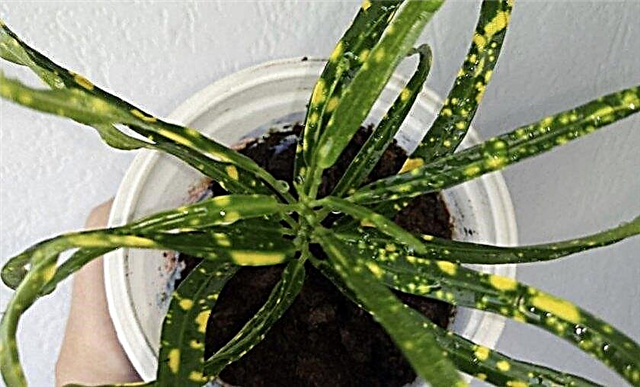
- epididymis (Appendiculatum): the leaves are oval, but in the middle part they have a narrowing, as if pulled by a belt;

- curly (Сrispum): leaves are narrow and wavy, very bright colors;

- Mrs. Iston (Mrs. Iceton): leaflets wide with tucked tips, painted with pink and burgundy spots, cream-colored blotches on young plants. Can be shaped like a neat tree;
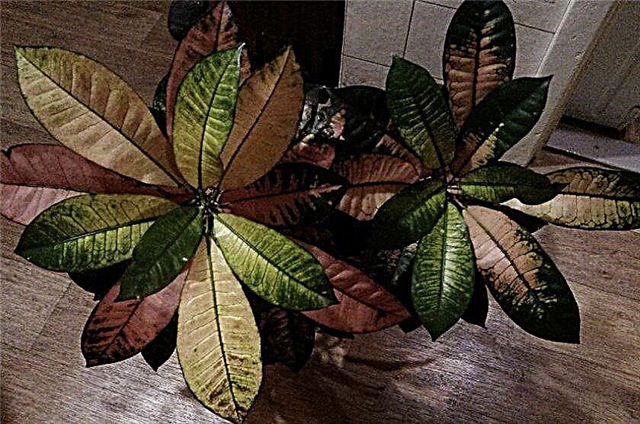
- Zanzibar (Zanzibar): narrowed, decoratively curved and very dense leaves, painted in purple, yellow and orange stripes on a green background;
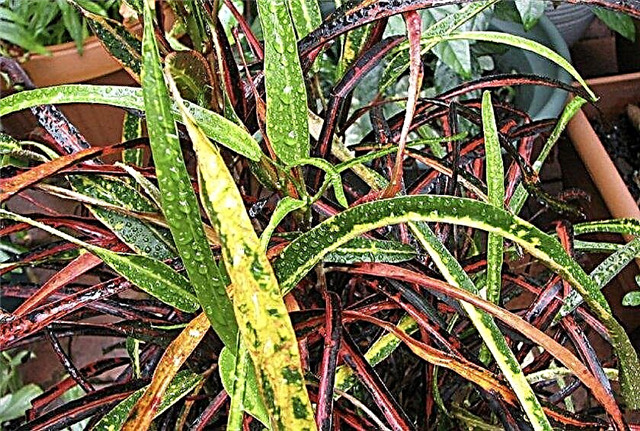
- Exlent (Excellent): the leaves resemble oak in shape, the color is the interweaving of spots and stripes of green and yellow, in the lower part they may be burgundy;
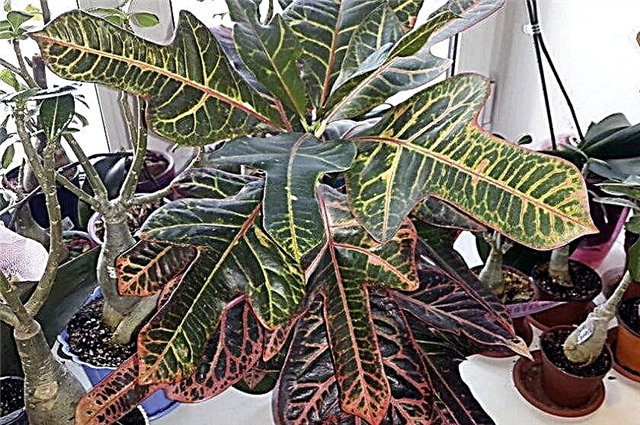
- Petra (Petra): leaves are oval, pointed or lobed, painted yellow at the edges and have yellow mottling in the center. The plant itself branches well;

- Disraeli (Disraeli): leaves are lanceolate, two-tone - in the lower part are green, in the upper are burgundy;
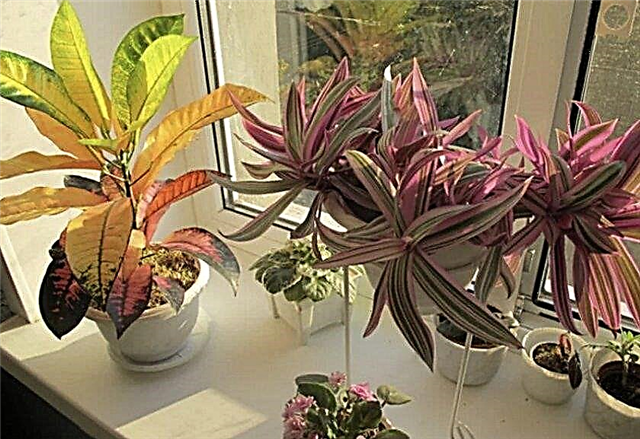
- Splashes of champagne (Splashes of champagne): narrow leaves, green color with a small yellow spot;

- Mummy (Mammi): differs in a great variety of both the shape of the sheet plate (elongated, curled, wavy) and its color;

- Tamara (Tamara): a light border in the form of spots on medium-sized leaflets;
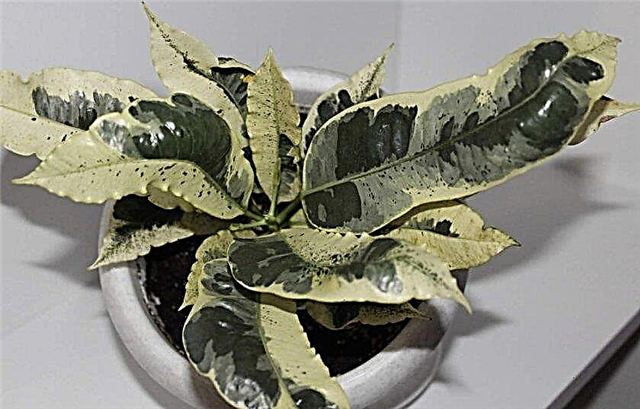
- Nervia (Nerve): jagged edges at long leaves with bright multi-colored coloring;

- Gold Sun (Gold sun): the leaves are oblong, narrow at the base, the plant itself is quite large and spreading;

- dragon (draco): the American variety of croton, the main value of which is a very valuable red resin, widely used in medicine and the chemical industry;

- prickly (echinocarpus): a variety very similar to a dragon, characterized by the presence of thorns in the fruit box;
- Cascarolla (Eluteria): another variety of medicinal croton, is also one of the few varieties whose flowers look very decorative and, in addition, have a great aroma (the word “cascarolla” is translated as “bark”, the name was given to the variety because its bark has numerous medicinal properties);
- laxative (tiglium): the leaf plate is green, appreciated for the oil contained in the seeds and having a pronounced laxative effect;

- Norm (Norma): leaves are large, first yellow-green, red-green as they form;

- Baron Jay de Rothschild (Baron J. De Rothschild): different brightness and variety of colors, which may include orange, pink, yellow and green colors in different shades;
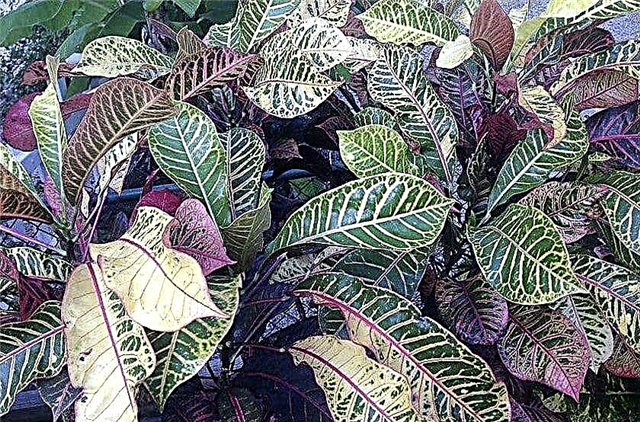
- Golden Star (Gold Star): leaves are long and narrow, connecting into rosettes, similar to stars, the color is green with yellow mottling;

- Apple leaf (Appleleaf): different red border on the foliage;

- Golden moon (Gold Moon): leaves are decorated with yellow stripes.
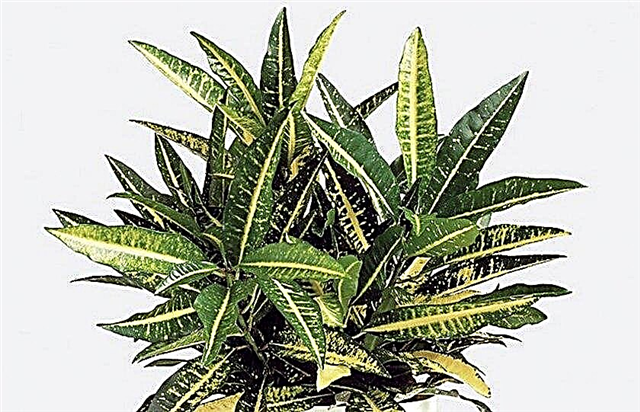
What conditions do you need to create at home
There is a version that it is the non-standard coloring of the codium leaves that determines its capriciousness. The lack of green in the terrestrial organs of the flower complicates the process of photosynthesis, which, as you know, allows you to provide the plant with the energy it needs. Therefore, in order for the croton to feel comfortable, it is so important to create the most favorable conditions for him, otherwise the flower may not endure the struggle for survival.
Did you know? In 1950, a special croton nursery was opened in the US state of Florida, where you can see more than five hundred different varieties of this plant.
Seat selection
 Wrong choice of place - the first mistake of an inexperienced grower, which can cost the code of life. The needs of croton in this regard are very contradictory, so it can be quite difficult to satisfy them. In particular, the owner needs to consider that this flower:
Wrong choice of place - the first mistake of an inexperienced grower, which can cost the code of life. The needs of croton in this regard are very contradictory, so it can be quite difficult to satisfy them. In particular, the owner needs to consider that this flower:
- He loves heat, but does not tolerate dry air, so it can not be placed near heating appliances;
- photophilous, but in direct sunlight receives burns and often discards foliage;
- absolutely not adapted to sudden changes in temperature, and from the slightest draft can die.
The best place for a codium is east or west windows. Far from the light, you can place those varieties of plants that have green leaves without rainbow splashes.Important! The brightness and variegation of the colors of the codium directly depends on the lighting, and not only its intensity, but also the duration plays a role here. Any sort of croton, being in the shade, has plain green leaves.
Temperature and humidity
Croton loves heat, but the problem is that in city apartments, both in the summer and during the heating season, the hot air is too dry, so the optimum temperature conditions for the plant are considered to be between +20 and +22 ºC, and the permissible maximum is at +28 ° C. In winter, these indicators are best maintained at the level of + 18 ... + 19 ° С. It is also important that the fluctuations between day and night temperatures do not exceed two to three degrees. Humidity is one of the most difficult conditions for codium care. The flower suffers so much from dry air that regular spraying cannot solve the problem. Experts recommend the use of additional humidifiers, for example, to place containers around the pot with moss, sand or expanded clay, and constantly add water to them. You can place the plant in a special glass container for growing - a florarium, where it is much easier to create a suitable microclimate for it.
Humidity is one of the most difficult conditions for codium care. The flower suffers so much from dry air that regular spraying cannot solve the problem. Experts recommend the use of additional humidifiers, for example, to place containers around the pot with moss, sand or expanded clay, and constantly add water to them. You can place the plant in a special glass container for growing - a florarium, where it is much easier to create a suitable microclimate for it.
In addition to moisturizing the air, an integral part of codium care is the regular removal of dust from leaf plates, otherwise the already complicated photosynthesis process may slow down even more. Periodically, the plant can be bathed in the shower, protecting the surface of the earth from the ingress of excess water.
How to care at home
It is noted that the biggest problems with codium arise immediately after its acquisition, even if all the conditions seem to be created for the plant. You should not worry about this: if the care is organized correctly, after a while the flower will adapt to a new place and come to life.
In the future, the state of the plant will directly depend on competent care, including, first of all, watering, top dressing, pruning and transplanting.Important! To facilitate the adaptation process, the plant brought from the store should be immediately watered and a transparent film should be left for a week in which the flower was packed. The microclimate and humidity inside it minimize the stress experienced by the croton as a result of the move.
Watering
Like any indoor flower, codium does not tolerate stagnation of water in the pot, but, unlike most other plants, even a slight and short drying of the substrate can be fatal for it, therefore, sufficient but not excessive watering is an essential component of caring for croton. The frequency of the procedure depends on the temperature in the room and the season: in summer, watering should be more plentiful, in the off-season and in winter - moderate. An excellent indicator of the correct irrigation is the degree of hardness of the plant's leaf plates, compared with the state of the soil: leaves falling down indicate a lack or excess of moisture in the pot (depending on whether the soil is dry or wet in the pot, the irrigation regime needs to be adjusted).
An excellent indicator of the correct irrigation is the degree of hardness of the plant's leaf plates, compared with the state of the soil: leaves falling down indicate a lack or excess of moisture in the pot (depending on whether the soil is dry or wet in the pot, the irrigation regime needs to be adjusted).
Water for irrigation should be used soft and slightly warmed up. Along with moistening the substrate, it is also worth spraying the plant itself.Important! Given the increased requirements for soil moisture and the simultaneous rejection of water stagnation during transplantation, you need to lay a reliable drainage layer in the pot.
Top dressing
So that the soil in the pot always remains nutritious and fertile, periodically, fertilizers must be applied to it - both organic and mineral. But too often this should not be done, since an excess of active substances can harm the plant. In the period from February to October, it is enough to feed once or twice a month, this process can be stopped for the winter. You can use any complex fertilizers for decorative and deciduous indoor plants, for example:
You can use any complex fertilizers for decorative and deciduous indoor plants, for example:
- “Clean sheet” (NPK Stimulus);
- "Master Agro";
- "Planton Z";
- Royal mix crystal spray
- “Quitofor Stimulus”;
- "Proventus";
- "Rost Master";
- "Rost Smaragd";
- "Agrecol" and others.
Important! From an excess of nitrogen in the soil, the croton leaves lose their brightness and become plain green.
Pruning
Another common mistake in caring for a croton is to ignore events such as pruning. With proper crown formation, the codium gets more space, suffers less from soil depletion and lack of energy, and also looks more attractive.
Pruning, in addition, can stimulate plant awakening after a winter dormant period, increase the number of lateral shoots, give the bush the desired shape and even treat a diseased flower by removing damaged stems and leaves.
The step-by-step cropping procedure looks like this:
- A sharp knife, secateurs or scissors are thoroughly wiped with alcohol and dried.
- The shoots selected for removal (diseased, broken, too long or old), as well as, if desired, flower buds are cut in one motion, so as not to cause unnecessary suffering to the plant.
- The place of cut is treated with chopped charcoal or fungicide for disinfection.

Transfer
The capricious croton painfully transfers the transplant, so even young plants are moved to a new pot no more than once every 2-3 years, as for adults, this period can be easily doubled. It is best to use the transshipment method for this purpose, transferring the flower to a larger flowerpot with an earthen lump, without exposing the roots. Partial renewal of the soil replaces the annual transplant: the topsoil is removed from the pot and replaced with a fresh substrate. The optimal time for transplanting is the end of winter or the beginning of spring when the plant wakes up. The pot for croton must be taken deep, so that at least a third of its volume is occupied by drainage. To make it easier for the plant to transfer the transplant, the diameter of the new flowerpot should not differ from the previous one by more than 10–20 mm.
The optimal time for transplanting is the end of winter or the beginning of spring when the plant wakes up. The pot for croton must be taken deep, so that at least a third of its volume is occupied by drainage. To make it easier for the plant to transfer the transplant, the diameter of the new flowerpot should not differ from the previous one by more than 10–20 mm.
Transplanting codium, you can use a ready-made substrate for decorative leafy plants, remembering that croton needs light and nutritious, slightly acidic (pH 5.5) soil, rich in humus. For self-preparation of the soil mixture, leaf and turf soil, sand, peat, humus or compost, as well as sphagnum and a small amount of charcoal are used. Small-sized varieties of croton grow well in a mixture of peat, compost and sand, without adding land as such.Important! Choosing the size of the pot, you need to take into account that the growth rate of different types of codeium is not the same: the larger the leaf plate, the faster it grows.
How to propagate
For all its capriciousness, croton is very easily propagated by rooting of cuttings. A little less commonly used is the seed method of producing new plants.
Cuttings
For rooting, it is best to use not young shoots, but older branches, partially (but not completely) stiffened, since they are less prone to decay.  The process looks like this:
The process looks like this:
- Cut the stalk to a right angle at a height of 10-15 cm from the top. One to three buds must be present on the shoot.
- The lower leaves from the shoot should be cut off, the milky juice that stands out from the wounds should be thoroughly washed off. The remaining leaves, if they are large, can be carefully folded with a tube and bandaged to better preserve moisture.
- Then it is desirable to incubate the cuttings for 24 hours in a solution with activated carbon or a growth stimulant (preparations such as Kornevina, Heteroauxin, Radifarma, Charkora).
- After this, the shoot is placed in a mixture of sand and peat and put in an impromptu greenhouse for rooting. The rooting place should not be very bright, but warm enough (+ 23 ... + 25 ºC), while it is desirable that the heat source is not from above, but from below, so it’s easiest to install a container with cuttings on the window sill of the battery.
Further care of the cuttings, lasting from one to one and a half months, consists in their regular ventilation and spraying, and it is recommended to add aloe juice to the water as a stimulant. When young plants start new shoots, they are immediately transplanted into separate pots with the usual soil mixture for croton.
Seeds
Before planting, seeds of codium must be placed in hot water for 30 minutes, and then soaked for 24 hours in water with the addition of growth stimulants. Then proceed as follows:
Then proceed as follows:
- Seeds are laid on the surface of a previously prepared substrate (sand and peat) and sprinkled on top with a thin layer of the same mixture up to 10 mm. The container is tightened with a film and placed in conditions similar to those described above for rooting cuttings. Shoots should appear in about two weeks.
- After this, the film must be started to be removed, first for a short time, then this period gradually increases so that the growing shoots gradually get used to the open air.
- After removing the film, the sprouts are watered and sprayed, and when they form three real leaves, they are transplanted into separate pots.
The lack of bright coloring of the leaves on young plants does not indicate a loss of decorative qualities of the croton: this is the peculiarity of this flower, unusual shades of its foliage appear with age, and most recently it happens with pink and red flowers.Important! The seed method of propagation of codium, unlike the vegetative one, does not guarantee the preservation of the signs of the mother in the new plant. This problem is relevant for all hybrid forms.

Growing difficulties
All difficulties arising from the content of croton, one way or another, are associated with the mistakes of the grower. What exactly is the problem can be understood by the reaction of the plant. For example:
- falling leaves indicate a violation of the temperature regime (subcooling, draft, temperature difference). It must be borne in mind, however, that seasonal discarding of foliage, especially of its lower and older parts, is the norm for codium;
- the absence or disappearance of bright coloring - a consequence of a lack of lighting or an excess of nitrogen fertilizers;
- small and deformed leavesOn the contrary, they say that the plant needs to be fed;
- brown spots on a leaf plate occur if the flower is exposed to direct sunlight, but if the darkening is located at the edges of the leaf, this may indicate hypothermia;
- drying leaf tips - A sure sign of insufficient air humidity. If the problem is not solved, the foliage will begin to fall;
- black coating on tissues is a symptom of a fungal disease called mob or soot fungus. The development of infection contributes to stagnation of water in the soil. It is treated by removing the affected areas and using fungicides containing copper ("Strobi", "Skor", "Flint", "Horus", "Ditan M-45" and others).
 The poisonous juice of croton usually repels pests, but a weakened plant can still be attacked by scale insects, thrips, nematodes, mealybug or red spider mites.
The poisonous juice of croton usually repels pests, but a weakened plant can still be attacked by scale insects, thrips, nematodes, mealybug or red spider mites.
Home value
Esotericists attribute to Croton a very strong energy, which can even change the atmosphere in the house.
At the same time, croton will make strong and confident people even more successful. This flower perfectly helps to collect your thoughts, believe in your abilities, increase self-esteem, set a goal and follow it without retreating. Also, codiyum is in perfect harmony with creative and independent natures, and it helps dull pessimists to look at the world more positively.Did you know? Kodiyeum is considered a vampire plant, which is happy to eat the vital forces of households, so it is better not to plant such a flower for weak, elderly and unhealthy people, especially those suffering from insomnia.
 The plant is credited with a strange property of developing oratorical abilities, the ability to convince in a dispute - mainly due to the ordering of thoughts and the acquisition of calm self-confidence.
The plant is credited with a strange property of developing oratorical abilities, the ability to convince in a dispute - mainly due to the ordering of thoughts and the acquisition of calm self-confidence.Taking into account all the described properties of the codeium, you can make a list of those to whom this plant is suitable, and to whom, on the contrary, it is undesirable to start it:
| Lifestyle and character traits with which croton harmonizes | Lifestyle and character traits with which croton conflicts |
| love of order | indiscipline, chaos in thoughts and deeds |
| phlegm, self-confidence | tendency to tantrums |
| problems with communication and argumentation in a dispute | increased talkativeness (amplify even more) |
| inability to force oneself to fulfill plans | workaholism (requires another plant that promotes relaxation) |
| creativity, creative profession | spontaneity in decision making |
In general, we can say that the code is suitable for those people who want to change and overcome difficulties, rather than dutifully go with the flow. For this reason, it is very useful to install it in offices.Did you know? Croton bloom is considered a bad omen. That is why, when buds appear, they are recommended to be removed immediately, but even after that, they should be very careful in their actions and deeds, trying to understand what exactly the flower was trying to warn about.
Croton is a very beautiful decorative and deciduous plant that needs to be created conditions that are rather difficult to provide in an ordinary city apartment. However, finding the right balance in lighting and providing the flower with regular watering, as well as maximum humidity, with the help of this amazing representative of the Euphorbia family, you can turn your home into a real tropical garden.























